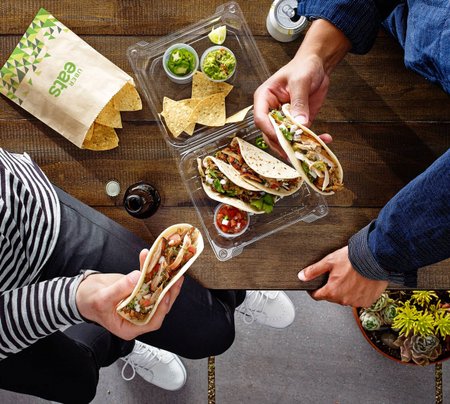Posted: Apr 24, 2018

In a tight labor market, the gig economy is adding a new wrinkle to the industry’s labor challenges.
As the labor market continues to tighten, restaurants are encountering a new competitor for a thinning pool of employees: Uber.
The ride-hailing service and similar companies that make up the gig economy are adding a new layer to the challenges of finding good workers.
Already facing high turnover and decreasing teenage labor participation, restaurants now have to compete with the independence and flexibility that such services provide to drivers.
“Restaurants are very vulnerable to the gig economy,” Victor Fernandez, executive director of insights and knowledge for the data firm TDn2K, said during the Restaurant Leadership Conference in Phoenix this week. When analyzing people who drive for companies such as Uber and Lyft, he said, “We’re really the primary match for that employee.”
Fernandez noted that two out of three front-of-house employees are part-time, working 25 hours. And they typically make low wages.
Those workers can be tempted by the flexible hours and independence that working for one of the delivery or ride-hailing services provides.
“Someone who suddenly discovers Uber is not looking at replacing 40 hours, they’re replacing 25,” Fernandez said. “We’re not offering full-time jobs. That’s why it’s so easy from the money perspective, the money and the flexibility.”
Low unemployment and strong hiring by restaurants have created an environment in which it’s difficult to find employees. Restaurants have added 200,000 jobs over the past year, according to federal data, and have added jobs at a higher-than-average rate for years.
That has shed a light on the competition the industry is facing for a dwindling pool of available workers from a growing number of competitors. Restaurants simply aren’t used to competing with companies that can offer the flexibility that ride-hailing services and other gig employers can provide.
The gig economy is “changing the power paradigm, who has the underhand, the employer or the employee,” said Joe Kefauver, managing partner with Align Public Strategies. “We’re used to competing against other restaurants for talent and other retailers. We’re not used to competing against hotel companies and transportation companies.”
This competition isn’t lost on the owners of restaurant companies, either.
“I make it a habit of talking to [Uber] drivers,” said Aziz Hashim, founder of Ruby Tuesday owner NRD Capital. “Eighty percent should have been working in the restaurant business. We’re losing talent to this type of gig economy.”
Joni Thomas Doolin, CEO of TDn2K, considers this one of the most difficult job markets in the industry’s history. She noted that voluntary turnover, staffing vacancies and job abandonment are at historic highs, and unemployment rates in many markets are as low as 2% to 3%.
In addition, baby boomers are retiring, and teenagers that have traditionally been the industry’s labor force lifeblood are not entering the workforce: Participation rate among teens is below 35%.
“You have a very constricted job market,” Doolin said.
For counter-service concepts, Fernandez said, turnover among hourly workers is 133%. Among managers, it’s 47%.
“Half of your leaders will not be here a year from now,” Fernandez said. “It’s the toughest job market we’ve seen in the restaurant industry.”
It’s not much better for table-service restaurants. Front-of-house turnover is 99%, back-of-house turnover is 109% and management turnover is 35%.
“We continuously see more and more managers leave their jobs,” Fernandez said, noting that many are leaving because they’re getting promotions or better offers elsewhere. “Money is becoming a huge reason.”
Replacing those managers isn’t cheap. The cost of turnover is $2,000 per front-of-house hourly worker and $1,902 per back-of-house hourly employee. For managers, that cost rises to $14,036, according to TDn2K.
The challenged labor environment could continue if immigration declines. The birth rate among native-born Americans, Doolin said, is 1.6 children. That rate needs to be 2.1 to 2.2 to maintain the population, she said. “We are well on our way to becoming Japan in terms of this whole issue,” she said.
That makes immigration important for population growth, and thus, growth in the number of potential workers as well as the number of potential customers. Immigration has accounted for 43% of population growth since 2010.
“We like bigger comp sales growth and bigger economic growth, but that means people,” Fernandez said.
One major issue in recent months has been the #MeToo movement and the focus on gender equity.
Women in all sectors make about 80 cents for every $1 their male counterparts make. Female restaurant managers make between 89% to 95% of the salaries made by males, according to TDn2K.
But women are less likely to be restaurant general managers. Though more than half of all restaurant nonmanagement employees are women, 48.5% of counter-service managers are women and 27.4% of table-service general managers are women, according to TDn2K.
Only 31.6% of counter-service multiunit managers are women, and 18.6% of table-service multiunit managers are women.
“As an industry, this is a chance to look at whether we are creating the right opportunities and right environment for women,” Fernandez said.
By Jonathan Maze
April 19, 2018
Source: Restaurantbusinessonline.com
Image Source: Uber.com
Go-Wine's mission is to organize food and beverage information and make it universally accessible and beneficial. These are the benefits of sharing your article in Go-Wine.com


The Wine Thief Bistro & Specialty Wines is a locally owned small business in downtown Frankfort, IL offering world class wines in a relaxed, casual gathering spot for friends and family. Offering world class virtual tastings and touchless carryout.
https://www.twtwineclub.com/aboutus
Go-Wine 25 Great Wineries in US selection prioritizes quality, value and availability.
www.go-wine.com/great-wineries-in-america
Tasting wine is a nice experience, but visiting the places in which wine is made is a magic moment. Available in New York City for touchless pickup.